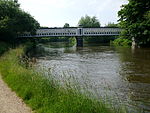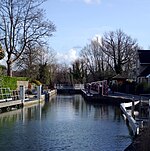Osney Rail Bridge
1850 establishments in EnglandBridges across the River ThamesBridges completed in 1887Oxfordshire geography stubsRailway bridges in Oxfordshire ... and 2 more
United Kingdom bridge (structure) stubsUse British English from December 2016

Osney Rail Bridge is a railway bridge over the River Thames at Oxford in England. It carries the Cherwell Valley Line between Didcot and Oxford across the river on the reach between Iffley Lock and Osney Lock. The original bridge was built in 1850, when the Great Western Railway built a new line from its original Oxford station at Grandpont to Rugby. The north side of the bridge was on the island which was then called Osney. A second bridge was built in 1887 within a foot or so of the first bridge.The bridge is maintained by Network Rail, who refer to the bridge as River Isis Crossing.
Excerpt from the Wikipedia article Osney Rail Bridge (License: CC BY-SA 3.0, Authors, Images).Osney Rail Bridge
Boney's Bridge, Oxford South Oxford
Geographical coordinates (GPS) Address External links Nearby Places Show on map
Geographical coordinates (GPS)
| Latitude | Longitude |
|---|---|
| N 51.747218 ° | E -1.267242 ° |
Address
Osney Rail Bridge
Boney's Bridge
OX2 0EW Oxford, South Oxford
England, United Kingdom
Open on Google Maps











